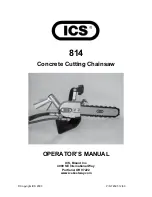
5
IMPORTANT SAFETY INSTRUCTIONS
SAVE THESE INSTRUCTIONS
•
Use extreme caution when cutting small brush and saplings, because small material may
catch the saw chain and be whipped toward you or pull you off balance.
•
When cutting a limb that is under tension, be alert for spring back, so that you will not be
struck when the tension in the wood fibers is released.
• Do not force the chainsaw. The job can be performed better if the saw is used at the rate that
it was designed to work at.
•
Always use the right product for your application. The chainsaw should be used for cutting
wood only. Never use the chainsaw to cut plastic, masonry or non-wooden building materials.
•
Do not use the chainsaw for purposes other than what it is intended for.
•
Store chainsaw when not in use. Chainsaw should be stored in a dry and high or locked area,
out of the reach of children.
•
Save these instructions. Refer to them frequently, and use them to instruct others who may
use this tool. If you loan someone this tool, also loan them these instructions.
W A R N I N G
Some dust created by power sanding, sawing, grinding, drilling, and other construction activities
contains chemicals known to cause cancer, birth defects or other reproductive harm. Some
examples of these chemicals are:
•
lead from lead-based paints
•
crystalline silica from bricks and cement and other masonry products, and
•
arsenic and chromium from chemically treated lumber.
Your risk of exposure to these chemicals varies depending on how often you do this type of
work. To reduce your exposure to these chemicals, work in a well-ventilated area, and work with
approved safety equipment, such as dust masks that are specially designed to filter out microscopic
particles.
Summary of Contents for 00-0000-0
Page 38: ...38 EXPLODED VIEW...
Page 41: ...41 NOTES...
Page 42: ...TOLL FREE HELPLINE 1 888 90WORKS 888 909 6757...






































